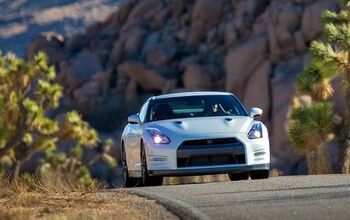2013 Nissan GT-R Review – Video

It’s the morning after. Literally… and figuratively.
FAST FACTS
| 1. The 2013 GT-R is priced at $96,820 and $106,320 for the Black Edition. |
| 2. Black Edition models get custom black Rays wheels, a red and black interior with Recaro leather seats and a dry carbon rear spoiler. |
| 3. Power from the twin-turbo 3.8L V6 has been increased to 545 hp and 463 lb-ft of torque. |
| 4. 11 display screens on the standard LCD monitor show everything from turbo boost to oil pressure, transmission temperature, steering angle, accelerator and brake position, as well as front to rear power distribution. |
Yesterday I went on a bender with the Nissan GT-R, shooting video for eight straight hours including plenty of acceleration runs. And now I’m suffering.
My neck feels like someone replaced my pillow with a cinderblock. With 463 lb-ft of torque, AWD and launch control, this is one street car you need a HANS device to drive.
But it wasn’t all debauchery. In fact, my time with the 2013 GT-R was highly educational. I’ve learned some new things about the Japanese supercar and about myself.
For starters, the GT-R is no longer on a pedestal in my mind and the reason is tied to something new I’ve learned about myself: I’m more of a car snob than even I thought possible.
This morning I’m waking up to the realization that while the GT-R remains an awesome feat of engineering, it’s more than a little rough around the edges.
WHAT IT DOES BEST
It may be a one-time Nurburgring lap champ, capable of demolishing Italian exotics worth triple its asking price, but there’s something the GT-R does even better than go fast – it looks like a supercar killer
I bring a lot of cars home and park them in my driveway, but nothing has brought out the neighborhood like the GT-R.
A shiny new Porsche 911? Sure it got a few heads to turn, but nothing more. The GT-R brought comments from everyone and a swarm of high school boys to my driveway, iPhone’s in hand and Facebook pics online in minutes.
Get the Flash Player to see this player.
Part of the attraction is its amazing performance, not to mention it’s the first ever GT-R to be offered in North America – a car that couldn’t be held in higher esteem by a generation that learned about cars from the Gran Turismo video game franchise.
It’s incredible to behold. The Godzilla name may be decades old, but this latest iteration is of monstrous proportions. With measurements that dwarf most cars on the road and a boxy look that accentuates them, the details deliver added impact with novelty size.
I am of course talking about the enormous gold brakes, the big rear spoiler and exhaust pipes that’ll have an F22 Raptor feeling insecure. The GT-R is so big, it makes 20-inch wheels look properly proportioned.
And yet despite it’s size and shape, the GT-R is as aerodynamic as a Prius.
SUPERCAR KILLER
Back to performance, the GT-R delivers acceleration and grip that defies physics.
Updated every year, for 2013 it now boasts 15 more horsepower and 15 more lb-ft of torque for a new total of 545-hp and 463 lb-ft from the same twin-turbo 3.8L V6.
According to some independent testing the car can hit 60 mph in just 2.7 seconds. I’m not able to corroborate that, but it certainly didn’t feel that alarming.
More fun is toying with those turbos, adding plenty of throttle, letting the boost build and waiting for full power to rocket you forward.
Straight line speed is one thing, but where the GT-R truly excels is in delivering outstanding grip thanks to its ATTESA ETS all-wheel drive system. Using complex mechanical bits and numerous electronic sensors it can adjust torque from a full 100% going to the rear wheels to an even 50/50 split. And it does so by measuring factors like speed, acceleration, steering angle, tire slip and yaw rate (essentially the difference between the car’s intended angle via the steering and its actual trajectory).
Using these factors, it behaves like a rear-drive car in most performance driving circumstances, while delivering full all-wheel drive grip when necessary, essentially delivering perfect dynamics and perfect grip.
As a result, the GT-R will let you drive to an incredibly high threshold making any driver a fast driver. Still, if you’re on a track, switch into R mode and the GT-R lets you do enough of the driving to make it an absolute thrill, due party to the fact that the speeds you can achieve are almost unbelievable.
NOT OUT-GUNNED, BUT DEFINITELY OUT-CLASSED
But as I mentioned earlier, the GT-R isn’t perfect. In fact, it’s far, far from it.
With its impressive size, comes plenty of mass. At 3,829 lbs it’s almost 800 lbs more than a Porsche 911.
It’s obvious that the folks at Nissan have either never heard of Colin Chapmin and his “add lightness” philosophy. Either that, or they think he’s an idiot.
Godzilla, as the GT-R is nicknamed, is a morbidly obese reptile.
Yes, it still dances around a race track like almost nothing else in the world, but think how much more amazing it would be if it dropped a few pounds – and by a few pounds, I mean 500.
Being a high-performance machine the GT-R isn’t expected to get very good fuel economy, which is a good thing, because it doesn’t. Nissan claims a 16-mpg city and a 23-mpg highway rating, neither of which are horrible. Unfortunately, even when not driven hard it managed just 14 mpg during our test.
And that portly weigh-in is likely part of the reason for the GT-R’s spring rates, which feel like they have all the bounce of an anvil on concrete. Apparently keeping all that weight in check during hard driving requires serious sacrifices in the comfort department.
True, there are three adjustable settings for the shock absorbers, but they don’t feel like they do anything.
After seeing what a company like Porsche can do to make a sports car genuinely livable for every day use, the GT-R feels unbearable.
The car’s dual-clutch transmission is also out-classed in the sport car segment, being much harsher and even slower than rival units.
Rough around the edges features might be endearing in a Honda CRX or a Lotus Elise, but in a car this large and heavy, it’s hard to feel anything but cheap.
Piling on the complaints, there’s launch control. Having had the opportunity to test it out back at the car’s US launch several years ago (pre warranty fiasco), this current version feels neutered. I recall vividly as all four wheels lost traction, delivering some slip but also acceleration that can honestly be described as awesome. Testing on the 2013 model, the only time the GT-R delivered any real loss of traction was on a degraded country road. On any other surface, it gripped immediately and scooted off with no fanfare at all.
Adding to the lack of occasion is the fact that the GT-R has no real exhaust note.
A bargain for this level of performance, it’s not hard to see where Nissan cut costs. The interior feels low grade compared to an Altima and while you’d expect the addition of carbon fiber on the dash to add something to the experience, the fact that it appears to be glued to the existing center console makes it actually look worse.
New for 2013 is an 11 speaker Bose audio system, with a standard back-up camera, while outside design updates include LED daytime running lights.
What is hard to find fault with is the LCD screen with 11 different displays to give you ever last performance measurement possible.
THE VERDICT
As disappointing as the interior is, mostly unchanged in a car that now costs almost 50 percent more than it did when it first hit out market, the GT-R remains perhaps the best performance bargain available. That makes it tough to hate on, even if six figures is a lot to pay for a car that will physically abuse you.
And you’ll feel it the next day, with an automotive hangover so bad you’ll swear off it forever. But that night, you’ll be looking to get your fix again.
LOVE IT
- Unbelievable outright performance
- Bargain price
- Supercar looks
LEAVE IT
- Uncomfortably stiff
- Cheap interior
- Launch control less dramatic

With AutoGuide from its launch, Colum previously acted as Editor-in-Chief of Modified Luxury & Exotics magazine where he became a certifiable car snob driving supercars like the Koenigsegg CCX and racing down the autobahn in anything over 500 hp. He has won numerous automotive journalism awards including the Best Video Journalism Award in 2014 and 2015 from the Automotive Journalists Association of Canada (AJAC). Colum founded Geared Content Studios, VerticalScope's in-house branded content division and works to find ways to integrate brands organically into content.
More by Colum Wood































Comments
Join the conversation
I want one.
Congratulations Colum for the nice article; I agree with you on every point except on Colin Chapman (not Chapmin) spelling. I have never driven a GT-R but I do own her little sister, the 370z. But cars are are a bargain considering their performance. Halas, both are seriously overweigth, thanks to Kazutoshi Mizuno who is supposed to be their chief engineer. This man cannot make the difference between mass and force and from what I have read he does not understand the basic dynamics of a car; I seriously doubt that he is an engineer. I do hope to see in the near future both cars lose weight; we will then see what they are capable of. Regards, Greg